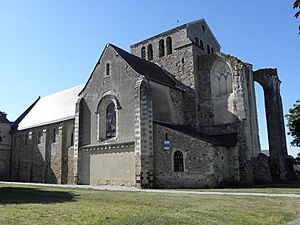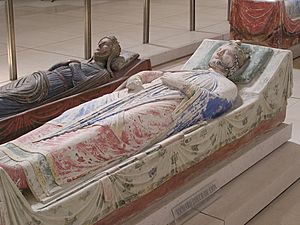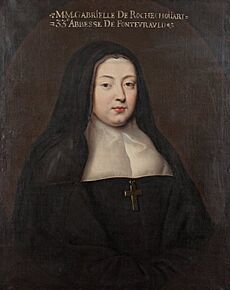Fontevraud Abbey facts for kids
| Abbaye Notre-Dame de Fontevraud | |
 |
|
| Monastery information | |
|---|---|
| Full name | Abbey of Our Lady of Fontevraud |
| Other names | Abbey of Fontevrault |
| Order | Order of Fontevrault |
| Established | 1101 |
| Disestablished | 1792 |
| Dedicated to | Our Lady |
| Diocese | Angers |
| People | |
| Founder(s) | Blessed Robert of Arbrissel |
| Important associated figures | Henry II of England, Eleanor of Aquitaine, Richard the Lionheart |
| Architecture | |
| Status | suppressed |
| Functional Status | Cultural Center & Museum |
| Heritage designation | Historic monument of France, World Heritage Site |
| Designated date | 1840 |
| Style | Romanesque, Gothic, Classical |
| Groundbreaking | 1101 |
| Site | |
| Coordinates | 47°10′53″N 0°03′06″E / 47.18139°N 0.05167°E |
The Royal Abbey of Fontevraud was a famous monastery in France. It's located near Chinon, in a region called Anjou. A preacher named Robert of Arbrissel started it in 1101. This abbey became the center of a new religious group called the Order of Fontevraud.
What made this order special was that it had both men and women living in the same abbey. They lived in separate areas but were all led by the Abbess (the head nun) of Fontevraud. The main Abbey of Fontevraud actually had four different communities, all managed by the same abbess.
The first buildings were constructed between 1110 and 1119. This area was once part of the Angevin Empire. Important historical figures like King Henry II of England, his wife Eleanor of Aquitaine, and their son King Richard the Lionheart were buried here in the late 1100s. The abbey stopped being a monastery during the French Revolution.
Today, Fontevraud Abbey is in the beautiful Loire Valley, which is a UNESCO World Heritage Site. It's also part of a large natural park. From 1804 to 1963, the abbey was used as a prison. Since 1975, it has been a cultural center and museum.
| Top - 0-9 A B C D E F G H I J K L M N O P Q R S T U V W X Y Z |
History of Fontevraud Abbey
Who Started the Abbey?
Robert of Arbrissel was a priest who worked to reform the church in the Diocese of Rennes. After his bishop died in 1095, Robert faced problems with other local clergy and left. He became a hermit, living a simple, strict life in the forest. Many people were inspired by his powerful speeches and his simple lifestyle.
In 1096, he founded a monastery for canons (a type of priest) at La Roë. Later that year, Pope Urban II gave him permission to preach anywhere. Robert's preaching attracted huge crowds, including men, women, and even people with leprosy. Many wanted to join a religious life. When the priests at La Roë didn't want to accept all these new people, Robert left that community.
Founding Fontevraud
Around 1100, Robert and his followers settled in a valley called Fons Ebraldi. Here, he started a new religious community. At first, men and women lived very closely together, which was an old practice. However, church leaders didn't approve, so the community soon separated by gender. The monks lived in smaller houses nearby and served the nuns, who were in charge.
In 1106, the community was officially recognized by the local bishop and by Pope Paschal II. Robert, who continued his travels and preaching, chose Hersende of Champagne to lead the community. Later, her assistant, Petronilla of Chemillé, became the first official abbess in 1115.
Robert wrote a short set of rules for the community, based on the Rule of St. Benedict. Unlike other monasteries with both men and women, everyone at Fontevraud followed the same rules. Robert's rules focused on silence, good deeds, simple food, and plain clothing. He also said that the abbess should not be someone who grew up in the abbey, but someone who had seen more of the world. This rule was only followed for the first two abbesses. When Robert died in 1117, there were about 3,000 nuns at Fontevraud.
The Plantagenet family, who ruled England, were big supporters of the abbey. Eleanor of Aquitaine, the widow of King Henry II of England, even lived at the abbey for a time. Abbess Louise de Bourbon later added her family symbol to many of the changes she made to the abbey buildings.
Challenges and Changes
After the Plantagenet family's power faded, Fontevraud and its smaller monasteries faced tough times. By the end of the 1100s, the abbess, Matilda of Flanders, reported that the abbey was very poor. Because of this, in 1247, the nuns were allowed to receive inheritances to help support themselves, which was unusual for monasteries. The Hundred Years War (which lasted through the 1300s) also caused a lot of damage and made things even harder. By 1460, many of the smaller monasteries connected to Fontevraud were almost empty or abandoned.
The Abbey Becomes a Prison
Due to financial difficulties, the youngest four daughters of King Louis XV of France were sent to the abbey to be raised until they were 15.
The Order of Fontevraud was broken up during the French Revolution. In November 1789, the French government declared that all property belonging to the Catholic Church in France now belonged to the nation. On August 17, 1792, a new rule ordered all monasteries to be emptied by October 1, 1792. At that time, about 200 nuns and a small group of monks still lived at Fontevraud. The last abbess, Julie Sophie Charlotte de Pardaillan d'Antin, is believed to have died in poverty in Paris in 1797.
In 1804, the abbey was turned into a prison. It was designed to hold 1,000 prisoners, and the old abbey buildings needed many changes. New barracks were built, and monastic areas were turned into dorms, workshops, and common rooms. Prisoners, including men, women, and children, began arriving in 1814. Eventually, the prison held about 2,000 prisoners. It became known as one of the toughest prisons in France. During World War II, under the Vichy Government, some French Resistance fighters were shot there.
In 1963, the abbey was given to the French Ministry of Culture. A big project began to restore the abbey. In 1975, the Centre Culturel de l'Ouest was created to protect the abbey and use it as a place for cultural events. The complex opened to the public in 1985. The restoration of the abbey church was finished in 2006.
A new group of the Order of Fontevraud, for women only, was started in 1806 by Mme Rose, following a changed set of rules.
Leaders of Fontevraud Abbey
Here is a list of some of the important abbesses who led Fontevraud Abbey:
- Petronille de Chemillé (1115–1149)
- Matilda of Anjou (1149–1154)
- Audeburge of Hautes-Bruyères (1155–1180) - She founded Amesbury Abbey in England in 1177.
- Gilles or Gillette (1180–1189)
- Adélaide (1189)
- Matilda of Flanders (1189–1194)
- Matilda of Bohemia (1194–1207)
- Marie of Burgundy (1207–1208)
- Alice of Bourbon (1208–1209)
- Adele (or Alice) of Brittany (1209–1218)
- Bertha (1218–1228)
- Alice of Blois (1228–1244)
- Mabile of La Ferté (1244–1265)
- Jeanne de Dreux (1265–1276)
- Isabeau Davoir (1276–1284)
- Marguerite de Pocey (1284–1304)
- Eleanor of Brittany (1304–1342)
- Isabel of Valois (1342-?)
- Marie of Brittany (1457–1477)
- Anne of Orléans (1477–1491)
- Renée de Bourbon (1491–1534)
- Louise de Bourbon (1534–1575)
- Éléonore de Bourbon (1575–1611)
- Louise de Bourbon de Lavedan (1611–1637)
- Jeanne-Baptiste de Bourbon (1637–1670)
- Gabrielle de Rochechouart de Mortemart (1670–1704)
- Louise-Françoise de Rochechouart de Mortemart (1704–1742)
- Marie-Louise de Timbrone (1753–1765)
- Julie-Gillette de Pardaillan d'Antin (1765–1792)
Architecture of the Abbey
The Abbey Church
The Cloister
The Chapter House
Royal Burials at Fontevraud
Fontevraud Abbey was originally the burial place for several important royal figures. These included King Henry II of England, his wife Eleanor of Aquitaine, their son King Richard I of England (also known as Richard the Lionheart), and their daughter Joan. Their grandson Raymond VII of Toulouse and Isabella of Angoulême (wife of King John) were also buried here.
However, the actual remains of these royals are no longer at the abbey. They were likely destroyed during the French Revolution. This was similar to what happened to the bodies of French monarchs, which were removed from the Basilica of St Denis in 1793.
Henriette Louise de Bourbon, a granddaughter of King Louis XIV, grew up at Fontevraud. Princess Thérèse of France, a daughter of King Louis XV, is also buried here.
See also
- History of medieval Arabic and Western European domes
- Nuneaton Priory – A related monastery in England

















